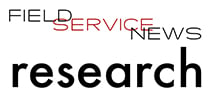In an age of information, does critical data remain locked away in business silos?
In a new series of features from the latest Field Service News Research study hosted in partnership with ServiceMax, we explore the correlations between asset data flow, servitization and cross-department collaboration. Here in the opening article of the series we outline the aim of the study...
There have been so many changes in our industry within the last two years. However, while much of the focus within the industry headlines have been focused on technology, there is also a seismic change in the very fundamentals of how we approach field service delivery.
Indeed, as we move forward, the very notion of field service may rapidly become antiquated as we move into a world of hybrid remote and physical service delivery.
In many ways, we were already on this path and had been for some time, but the unprecedented disruptive force of the pandemic forced our hand, and our journey along that path was hugely accelerated.
The pandemic was a disruptive force of a magnitude not seen in generations. Parallels to the second world war were frequent, yet our world is so much more connected than in the past. We live in an era of true globalization, and thus, the shockwaves of that disruption were felt within the wheels of industry more keenly than anything that has come before.
Yet, in adversity, there is always opportunity. Many in the field service sector have grasped the nettle and chosen a path of genuine innovation in terms of the technology they are leveraging and their core strategic thinking.
We are living in the age of information, a time when data underpins all aspects of excellence within a service-centric organization
We have discussed digital transformation at length in our industry. Still, the truth is that no matter how sophisticated the tools we use are, they remain merely an enabler for service transformation.
We are living in the age of information, a time when data underpins all aspects of excellence within a service-centric organization. Yet, so often, the ability to take meaningful and actionable insight from the data available to us remains locked away in business siloes.
Previously, this would be down to a challenge with the transmission of data across different systems of record. Yet, while this can still prove to be an obstacle to overcome, modern systems are more open to integration than ever before. The challenge for many is as much about the ability to rethink the status quo.
To look at the organization with fresh eyes and to take an Outside-In approach that no longer sees the various internal challenges and barriers that build departmental silos, but instead to see how each department can work alongside each other in harmony towards a collective goal that sits in line with the concepts of servitization and outcome-based solutions that are becoming more and more compelling every year.
It is, of course, easy to write down the merits of such an approach, yet as many of us know all too well, it is far harder to implement.
The core focus of this latest Field Service News Research study, therefore, was to understand how prevalent the use of asset data, data that has deep and rich value for the entire business is within service organizations – or does the data remain within a silo of operations.
In addition to this, we shall explore whether the movement of data across an organization is a significant factor in enabling greater cross-department collaboration. This in itself is an indicator of an organization’s appetite and capability to adopt servitization.
In the study, we spoke to a sample of over 230 field service leaders from a variety of different industry verticals including manufacturing, utilities, telecommunications, power generation, healthcare, med-tech, security and many others.
The study was conducted between September and November 2021 and data was collected online via personal invitations to participate. The data presented in this report is quantitative. We are currently undertaking interviews with a selection of respondents for our final report within this study which will then be based on further qualitative data yielded in those interviews
 If you are a Field Service News subscriber on either our free-forever FSN Standard subscription tier or our Premium Subscription tier you can access the full 18-page report written by Field Service News, Editor-in-Chief, Kris Oldland that offers in-depth analysis of the research project now on the button below.
If you are a Field Service News subscriber on either our free-forever FSN Standard subscription tier or our Premium Subscription tier you can access the full 18-page report written by Field Service News, Editor-in-Chief, Kris Oldland that offers in-depth analysis of the research project now on the button below.
If you are not yet a subscriber to Field Service News but would like to subscribe and gain access to this report instantly, click the button to visit a dedicated registration page for our complimentary sponsored subscription tier and that will give you instant access to this paper and a number of other assets currently available to subscribers on this tier.
 Data usage note: By accessing this content you consent to the contact details submitted when you registered as a subscriber to fieldservicenews.com to be shared with the listed sponsor of this premium content, ServiceMax who may contact you for legitimate business reasons to discuss the content of this study.
Data usage note: By accessing this content you consent to the contact details submitted when you registered as a subscriber to fieldservicenews.com to be shared with the listed sponsor of this premium content, ServiceMax who may contact you for legitimate business reasons to discuss the content of this study.
Written by Kris Oldland
Kris Oldland has been working in Business to Business Publishing for almost a decade. As a journalist he has covered a diverse range of industries from Fire Juggling through to Terrorism Insurance. Prior to this he was a Quality Services Manager with a globally recognised hospitality brand. An intimate understanding of what is important when it comes to Service and a passion for emerging technology means that in Field Service he has found an industry that excites him everyday.


